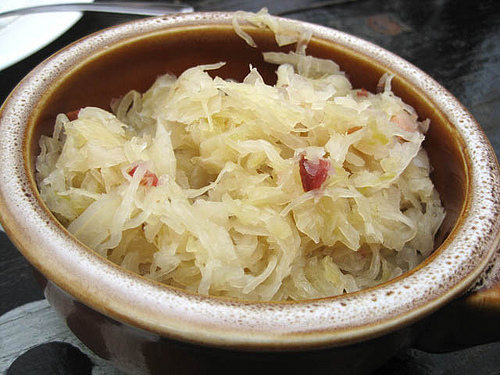
Sauerkraut is one of those things that is very polarizing. People either love it or hate it. I am definitely in the love camp. It reminds me of slow cooked meals that make the house smell fabulous, of days turning colder and warm and soothing comfort food. That could be due to my German genes and definitely from growing up in a German household.
Sauerkraut is cabbage that has been fermented in salt over a long period of time. That is it…salt and cabbage and time are the only ingredients. When cooking with it you can decrease the sour taste by rinsing it well under water but, if you are like me, and you enjoy the sour taste then leave it as it comes.
The acid in Sauerkraut makes it perfect to braise meat in since the acid breaks down the ligaments in tougher pieces of meat and the flavor brings complexity to the dishes with remarkably few ingredients. So today I will give you instructions on how to make Sauerkraut if you so desire and also how to use it.
How to Make Sauerkraut
From the Farmers Almanac: http://www.almanac.com/content/how-make-sauerkraut
Tips Before You Start
- Sauerkraut is prepared entirely in a brining crock. Don’t worry about going out and buying an expensive stoneware crock—”crocks” can be any unchipped enamel pot or large glass jar. The gallon, wide-mouth jars that restaurants use to buy pickles in work beautifully.
- If you have an old crock you want to use, don’t use it if there is a white film on the inside that disappears when wet and reappears upon drying. That crock has been used for waterglassing eggs; there is no way to remove it and it will ruin your sauerkraut.
- The old jingle “A hand in the pot spoils the lot” is completely true. Keep your hands, and any metal object, out of the crock. Use wooden spoons and mashers and glass or crockery for dipping and weighting.
- The best and freshest ingredients will yield the best sauerkraut. You can make relish with your old, tough cabbage, but use your young, fresh, tender cabbage for your sauerkraut.
Making Your Sauerkraut
Sauerkraut has many uses; from piling it on sandwiches to covering bratwurst to even making a cake with it, you will have no trouble finding uses for your homemade sauerkraut.
- For a 1-gallon container, core and shred 5 pounds of cabbage. Measure out 3 tablespoons of pickling (or kosher or dairy) salt.
- Alternate layers of cabbage with a sprinkling of salt, tapping each layer with a wooden spoon or potato masher. The top layer should be salt. This will not seem like it’s enough salt, but it will give you a 2 1/2 percent solution, the perfect strength for fermentation.
- Boil an old dish towel or piece of sheeting for 5 minutes and cover the crock with it. Weight this down with a flat plate the size of the inside of the crock and weight it down with a canning jar full of water. If you’re using a glass jar, you won’t need to weight it down. Let it sit for a day.
- If you used fresh and tender cabbage, by the next day you should have enough brine to cover the cabbage. If you don’t, make more brine by adding 1 1/2 teaspoons to a cup of water and add enough to cover.
- In 2 or 3 days, white scum will form on the top. Skim this off, replace the cloth with a newly boiled one, wash the plate, and replace it all. Repeat this skimming (a 5-minute job) each day until the bubbles stop rising, or for about 2 weeks. Then your sauerkraut is done!
- At this point, simply keep the cabbage below the brine with the plate, cover the crock tightly, and store at 40°F to 50°F. If your cellar isn’t that cool, heat the sauerkraut just to simmering, pack in canning jars, seal, and process in a water bath 20 minutes for quarts, 15 minutes for pints.





